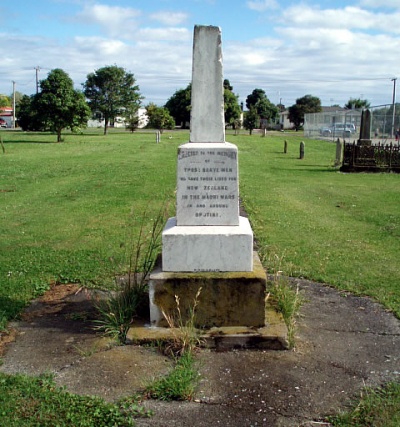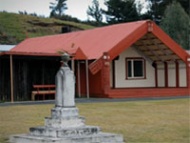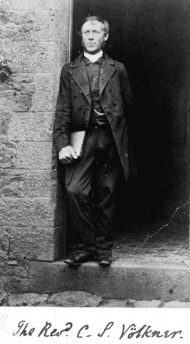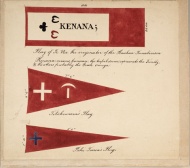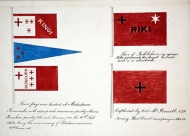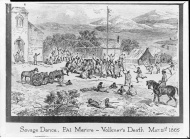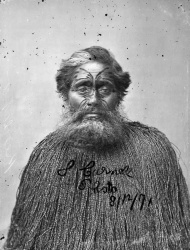Events In History
-
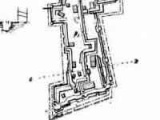 21 July 1865Capture of Weraroa pā
21 July 1865Capture of Weraroa pāGovernor George Grey led a small force that captured a Pai Mārire (Hauhau) pā at Weraroa, Waitōtara. The pā had long lost its strategic significance, and its small garrison had seemed willing to surrender. Read more...
-
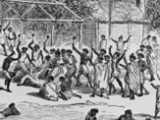 2 March 1865Missionary Carl Völkner killed at Ōpotiki
2 March 1865Missionary Carl Völkner killed at ŌpotikiThe missionary Carl Völkner was hanged from a willow tree near his church at Ōpōtiki by followers of a new religion, Pai Mārire. Read more...
-
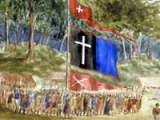 30 April 1864Pai Mārire defeated at Sentry Hill, Taranaki
30 April 1864Pai Mārire defeated at Sentry Hill, TaranakiIn one of their first military efforts, several hundred Pai Mārire warriors attacked a British redoubt at Te Mōrere (Sentry Hill) in Taranaki. Scores were killed and wounded. Read more...
-
 6 April 1864Pai Mārire ambush in Taranaki
6 April 1864Pai Mārire ambush in TaranakiA British patrol was ambushed by Pai Mārire warriors near Ōakura. The heads of the seven men killed were taken around the North Island by Pai Mārire disciples to encourage enlistment in the movement. Read more...
Articles
Pai Marire

Pai Marire (goodness and peace) was one of several Maori Christian faiths to emerge in the 19th century. Like many others, it was closely tied to issues of land and politics.
-
Page 2 – Te Ua Haumēne
Pai Marire disciples travelled around the North Island in the mid-1860s. Against a backdrop of war and land confiscations, the founding principle of Pai Marire was often
-
Page 3 – The death of Carl Völkner
The ritual killing by Pai Mārire followers of missionary Carl Völkner in 1865 shocked many people. The government used the event as a reason to take harsh action against Pai
-
Page 4 – Further information
This web feature was written by Steve Watters and produced by the NZHistory.net.nz team.
Tītokowaru's war

In the 1980s James Belich argued that Tītokowaru’s war had become a ‘dark secret’ of New Zealand history, ‘forgotten by the Pākehā as a child forgets a nightmare’. For Belich, Tītokowaru was ‘arguably the best general New Zealand has ever produced’.
-
Page 3 – The year of the lamb
Tītokowaru proclaimed 1867 as ‘the year of the daughters … the year of the lamb’. His efforts for ‘reconciliation and peace’ were quite remarkable, given the events of the
-
Page 4 – The war begins
In March 1868 Tītokowaru authorised a muru (punitive plunder) against Pākehā involved in the confiscation of land at Ketemarae (Normanby).
-
Page 5 – Turuturumōkai
In the pre-dawn darkness on Sunday 12 July 1868, 60 of Tītokowaru’s warriors led by Haowhenua bypassed the large colonial force at Waihī Redoubt and struck at nearby
-
Page 6 – Crisis of confidence
News of Te Kooti’s assault on Matawhero in Poverty Bay a few days after the defeat at Moturoa raised serious questions about the Armed Constabulary’s ability to protect
Māori King movement - 1860-94

King Tāwhiao's reign was dominated by the Waikato War and its fallout.
- Page 4 - RaupatuUnder the terms of the New Zealand Settlements Act 1863 the government confiscated 1.2 million acres (486,000 hectares) of Māori land in late
New Zealand's 19th-century wars

War changed the face of New Zealand in the 19th century. Tens of thousands of Māori died in the intertribal Musket Wars from the 1810s to the 1830s. There were fewer deaths during the New Zealand Wars (1840s-1870s) between Māori and the Crown, but the consequences were still dire for many tribes.
-
Page 5 – End of the New Zealand Wars
The New Zealand Wars ended in 1872. European settlers prevailed through weight of numbers and economic power. By 1900, New Zealand was a settler society, with Māori pushed out
-
Page 8 – NZ Wars flags
For many Maori in the 19th century, the Union Jack was frequently viewed as a potent symbol of Great Britain's power in New Zealand. In the New Zealand Wars, Maori parties who
War in Whanganui

The confusion and uncertainty that had surrounded the New Zealand Company's land purchases in Whanganui erupted into violence in the autumn and winter of 1847. The conflict here also involved longstanding rivalries between upper and lower Whanganui River Māori.
- Page 5 - Moutoa IslandThe Pai Mārire religion divided Māori. Some supported it, but others mistrusted its political intent. Events on the Whanganui River in 1864 showed the conflict about the faith
War in Taranaki 1860-63

In March 1860 war broke out between Europeans and Māori in Taranaki following a dispute over the sale of land at Waitara. It was the beginning of a series of conflicts that would dog Taranaki for the next 21 years, claiming the lives of several hundred Maori and Europeans and leaving deep scars that persist to the present day.
- Page 8 - The second Taranaki warOn 12 March 1863, 300 men of the 57th Regiment evicted Maori from the land they had occupied at Tataraimaka, 20 km south-west of New
Biographies
-
 Wahawaha, Rāpata
Wahawaha, Rāpata
Ngāti Porou leader Rāpata Wahawaha opposed the Pai Mārire religion and sided with the government against its followers. He was later presented with a ceremonial sword by Queen Victoria for services to the Crown during the New Zealand Wars.
Read more... -
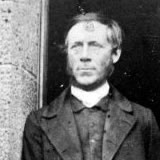 Völkner, Carl Sylvius
Völkner, Carl Sylvius
On 2 March 1865 Carl Völkner, a German-born missionary, was hanged from a willow tree near his church at Opotiki. Followers of a new religion, Pai Marire, who suspected Völkner of spying for the government, were held responsible.
Read more... -
 Te Ua Haumēne
Te Ua Haumēne
In 1862 Te Ua Haumēne established a new religion, Hauhau based on the principle of pai marire – goodness and peace. Most settlers viewed Hauhau as a anti-European religion that became synonymous with ‘violence, fanaticism and barbarism’.
Read more...
Related keywords
- new zealand wars
- riwha titokowaru
- taranaki
- george grey
- te ua haumene
- duncan cameron
- missionaries
- carl völkner
- religion
- race relations
- roadside stories
- te haroto
- maori leaders
- te kooti
- flags
- kingitanga
- christianity
- moutoa gardens
- land confiscation
- ngati porou
- rapata wahawaha
- opotiki
- whakatohea
- whanganui city
- whanganui river
- te ati awa
- NZ Wars memorial
- king country
- kereopa te rau
- mary aubert
- potatau te wherowhero
- tukaroto potatau matutaera tawhiao
- treaty of waitangi
- te arawa
- painting
-
Main image: Ōpotiki NZ Wars memorials
This memorial obelisk commemorates unnamed men who were killed in action or died of wounds received in and around Opotiki during the New Zealand Wars. Six men known to be buried at Kelly Street are commemorated on a memorial tablet.

